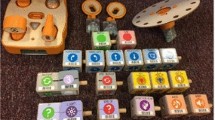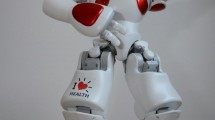Abstract
Educational robotics (ER) uses robotic kits as a channel for education and collaborative learning in a play setting. Thanks to adaptability of robots, ER could facilitate inclusion of special-needs children, such as children with Down syndrome (DS), in learning programs. In a previous study, we provided evidence that ER could promote superior cognitive functions, such as executive functions, which are involved in problem solving, reasoning and planning in typically developing preschool children. In this preliminary study, we aimed to evaluate ER training feasibility, adapting methodology and previously experimented activities to promote executive functions in DS children. Eight DS children carried out 45-min weekly group sessions for 8 weeks in an ER laboratory (ER-Lab) using the Bee-Bot. Training setting was generally well-suited for this small sample of DS children. Due to sample heterogeneity, qualitative results of only two exemplificative children are presented and discussed. Results indicate that Bee-Bot is a very significant device for promoting interest, attention and interaction with adults and peers. Promotion of executive functions seemed to be possible in one child, who eagerly participated in ER-Lab activities.
Similar content being viewed by others
References
Alimisis, D. (2013). Educational robotics: Open questions and new challenges. Themes in Science and Technology Education, 6(1), 63.
Benitti, F. B. V. (2012). Exploring the educational potential of robotics in schools: A systematic review. Computers & Education, 58(3), 978–988.
Bers, M. U., Flannery, L., Kazakoff, E. R., & Sullivan, A. (2014). Computational thinking and tinkering: Exploration of an early childhood robotics curriculum. Computers & Education, 72, 145–157.
Bisiacchi, P. S., Cendron, M., Gugliotta, M., Tressoldi, P. E., & Vio, C. (2005). BVN 5-11: batteria di valutazione neuropsicologica per l’età evolutiva. Trento: Centro studi Erickson.
Businaro, N., Zecca, L., & Castiglioni, M. (2014). Implicazioni psicologiche di un laboratorio di robotica educativa nella scuola primaria: riflessioni sul caso di un bambino con ritardo mentale. Psicologia clinica dello sviluppo, 18(2), 311–318.
Clark, C. A. C., Pritchard, V. E., & Woodward, L. J. (2010). Preschool executive functioning abilities predict early mathematics achievement. Developmental Psychology, 46(5), 1176–1191.
Conchinha, C. (2015). Playful learning: Educational robotics applied to students with learning disabilities. In 2015 International symposium on computers in education (SIIE) (pp. 167–171). IEEE.
Di Lieto, M. C., Inguaggiato, E., Catro, E., Cecchi, F., Cioni, G., Dell’Omo, M., Laschi, C., Pecini, C., Santerini, G., Sgandurra, G., Dario, P. (2017). Educational robotics intervention on executive functions in pre-school children: A pilot study. Computers in human behavior, 71, 16–23.
Diamond, A. (2012). Activities and programs that improve children’s executive functions. Current Directions in Psychological Science, 21(5), 335–341.
Diamond, A. (2013). Executive functions. Annual Review of Psychology, 64, 135–168.
Diamond, A., & Lee, K. (2011). Interventions shown to aid executive function development in children 4 to 12 years old. Science, 333(6045), 959–964.
Garon, N., Bryson, S. E., & Smith, I. M. (2008). Executive function in preschoolers: A review using an integrative framework. Psychological Bulletin, 134(1), 31.
Hussain, S., Lindh, J., & Shukur, G. (2006). The effect of LEGO training on pupils’ school performance in mathematics, problem solving ability and attitude: Swedish data. Journal of Educational Technology & Society, 9(3), 182–194.
Janka, P. (2008). Using a programmable toy at preschool age: Why and how. In Teaching with robotics: Didactic approaches and experiences. Workshop of international conference on simulation, modeling and programming autonomous robots (SIMPAR 2008).
Johnson, D. W., & Johnson, R. T. (1994). Learning together and alone. Cooperative, competitive, and individualistic learning. Needham Heights: Allyn and Bacon.
Kazakoff, E. R., Sullivan, A., & Bers, M. U. (2013). The effect of a classroom-based intensive robotics and programming workshop on sequencing ability in early childhood. Early Childhood Education Journal, 41(4), 245–255.
Korkman, M., Kirk, U., & Kemp, S. (2007). NEPSY-II. San Antonio, TX: Pearson.
Leroux, P. (1999). W4: Educational robotics. International Journal of Artificial Intelligence in Education, 10, 1080–1089.
Mammarella, I. C., Toso, C., Pazzaglia, F., & Cornoldi, C. (2008). Il Test di Corsi e la batteria BVS per la valutazione della memoria visuospaziale [The Corsi blocks task and the BVS battery for visuospatial memory assessment]. Trento: Erickson.
Marshall, P. J., & Drew, A. R. (2014). What makes Simon Says so difficult for young children? Journal of Experimental Child Psychology, 126, 112–119.
Miyake, A., Friedman, N. P., Emerson, M. J., Witzki, A. H., Howerter, A., & Wager, T. D. (2000). The unity and diversity of executive functions and their contributions to complex “frontal lobe” tasks: A latent variable analysis. Cognitive Psychology, 41(1), 49–100.
Nugent, G., Barker, B., & Grandgenett, N. (2008). The effect of 4-H robotics and geospatial technologies on science, technology, engineering, and mathematics learning and attitudes. In EdMedia: World conference on educational media and technology (Vol. 2008, No. 1, pp. 447–452).
Papert, S. (1980). Mindstorms: Children, computers, and powerful ideas. New York: Basic Books, Inc.
Robins, B., Dautenhahn, K., Ferrari, E., Kronreif, G., Prazak-Aram, B., Marti, P., et al. (2012). Scenarios of robot-assisted play for children with cognitive and physical disabilities. Interaction Studies, 13(2), 189–234.
Robins, B., Dautenhahn, K., TeBoekhorst, R., & Billard, A. (2005). Robotic assistants in therapy and education of children with autism: Can a small humanoid robot help encourage social interaction skills? Universal Access in the Information Society, 4(2), 105–120.
Robins, B., Dickerson, P., Stribling, P., & Dautenhahn, K. (2004). Robot-mediated joint attention in children with autism: A case study in robot-human interaction. Interaction Studies, 5(2), 161–198.
Rueda, M. R., Checa, P., & Combita, L. M. (2012). Enhanced efficiency of the executive attention network after training in preschool children: Immediate changes and effects after two months. Developmental Cognitive Neuroscience, 2, S192–S204.
Traverso, L., Viterbori, P., & Usai, M. C. (2015). Improving executive function in childhood: Evaluation of a training intervention for 5-year-old children. Frontiers in Psychology, 6(525), 1–13.
Urgesi, C., Campanella, F., & Fabbro, F. (2011). NEPSY-II. Contributo alla Taratura Italiana. Florence: Giunti OS.
Usai, M. C., Viterbori, P., Traverso, L., & De Franchis, V. (2013). Latent structure of executive function in five- and six-year-old children: A longitudinal study. European Journal of Developmental Psychology, 11(4), 447–462.
Valeri, G., Stievano, P., Ferretti, M. L., Mariani, E., & Pieretti, M. (2015). BAFE: Batteria per l’Assessment delle Funzioni Esecutive. Florence: Hogrefe.
Vygotsky, L. (1987). Zone of proximal development. Mind in Society: The Development of Higher Psychological Processes, 5291, 157.
Wechsler, D. (1989). Wechsler preschool and primary scale of intelligence—Revised. San Antonio, TX: The Psychological Corporation.
Wechsler, D. (2002). WPPSI-III administration and scoring manual. Psychological Corporation.
Wechsler, D. (2003). Wechsler intelligence scale for children-WISC-IV. San Antonio: Psychological Corporation.
Acknowledgements
The authors would like to thank the parents of the children who participated in this study and the Fondazione TIM which is supporting the ER research activity of our group.
Author information
Authors and Affiliations
Corresponding author
Rights and permissions
About this article
Cite this article
Bargagna, S., Castro, E., Cecchi, F. et al. Educational Robotics in Down Syndrome: A Feasibility Study. Tech Know Learn 24, 315–323 (2019). https://doi.org/10.1007/s10758-018-9366-z
Published:
Issue Date:
DOI: https://doi.org/10.1007/s10758-018-9366-z




